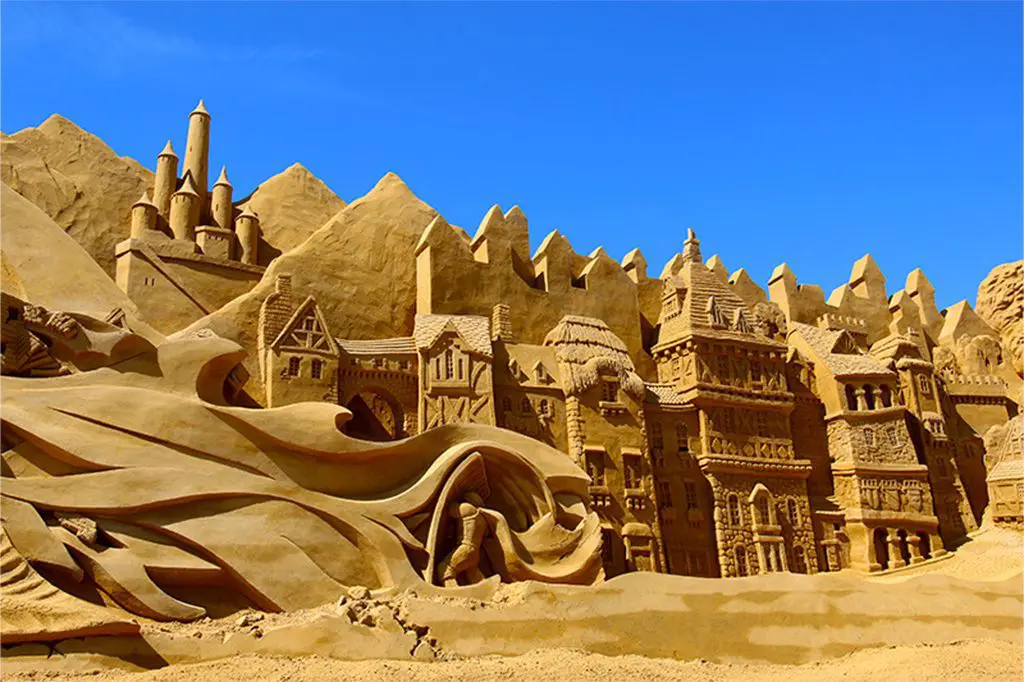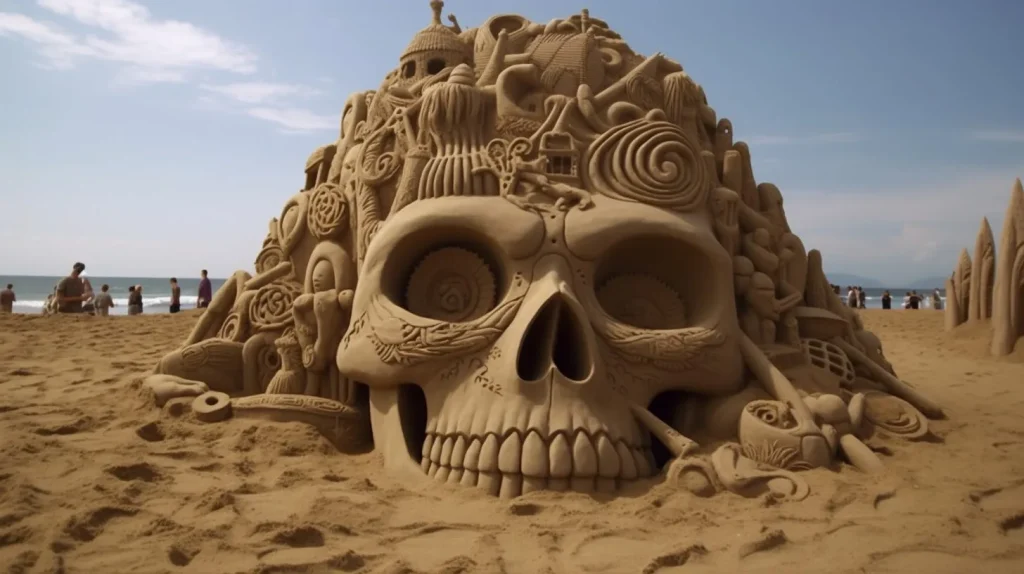The Art of Sand Sculpting: Techniques and Festivals Around the World

Welcome to the mesmerizing world of sand sculpting! If you’ve ever strolled along a picturesque beach, you may have marveled at the intricate and awe-inspiring sand sculptures that dot the coastline. In this article, we will unravel the secrets behind this ancient and captivating art form, delving into the techniques used by talented sculptors and exploring the fascinating festivals that celebrate their creations around the world.
History of Sand Sculpting
It is difficult to pinpoint the exact beginnings and history of sand sculpting. Nevertheless, sand sculptures have been uncovered dating back thousands of years in civilizations such as Egypt, Mesopotamia, Greece, and India. In each of these civilizations, sand sculptures were ritualistic or provided reverence to deities as an offering.
The practice was carried forward through different cultures. For example, in the 14 th century of Japan, the practice of building sand mandalas performed by monks. Such sculpting practices were deemed “suna-no-e,” used to benefit the underserved to provide relief and spiritual tranquility.
Additionally, in India, sand sculpting, also known as “talapatrachitras,” was utilized to depict stories about gods and goddesses.

Techniques Used in Sand Sculpting
Sculpturing anything using sand is no walk in the park. It is not just the fragile nature of the material that presents challenges to artists. Sand sculptors have mastered various techniques to help them bring their imaginative works into existence. One of the most commonly deployed methods is piling and sculpturing. Sculptors start by gathering a pile of sand, after which they sculpt and chisel bits layers away to realize the statue.
This process necessitates the utmost precision on the side of the artist. Failure to meticulously perform the process may lead to the destruction of the entire structure. Second, sand sculptors have been welcoming a layered sculpturing model in the recent past. With this approach, sculptors create multiple layers of sand with different densities. This way, each layer adds depth and detail to the sculpture. The sculptors finally sculpt and chisel each of the layers to create highly detailed shapes. The final technique sculpture artists use is sculpturing using a mold.
These molds, which can be metallic, plastic, or wooden, are used to shape sand. Sculptors then carefully pour the wet sand into them. Once the material has hardened, they remove the molds, leaving behind the sculptured shape. Sculptors use this approach when aiming to attain detailed shapes that would be cumbersome to cut into using the traditional sculpturing techniques.
Tools Required for Sand Sculpting
As much as the true magic behind a sand sculptor comes from the artist, a record of tools is essential to actualize one’s visualization. Such tools are simple and plain where the most basic ones are the artists’ hands used to sculpt the sand. The hands enable the artists to accurately create their desired designs with diligent consideration of the critical aspects.
Other tools include shovels and buckets for packing and transporting sand. For carving and shaping the sculpting block, trowels and palette knives are ideal. On the other hand, brushes and spray bottles filled with water are functional in adding moisture for block solidarity. In terms of finer details, sand sculptors can choose dental tools, spoons, or ore pastry knives.
However, without the artist’s skill and mastery of the medium, the tools themselves are useless.
Tips for Creating a Successful Sand Sculpture
Creating a successful sand sculpture requires a combination of technical skill, artistic vision, and practical knowledge. Here are some tips to help you make the most of your sand sculpting endeavors:
- Choose the right sand: Not all sand is suitable for sculpting. Look for sand that is fine-grained and has a high clay content, as this will provide better cohesion and stability. Avoid sand that is too dry or too wet, as it will be difficult to work with.
- Start with a solid base: Before building your sculpture, create a sturdy and compacted base. This will provide a solid foundation and prevent your sculpture from collapsing prematurely.
- Add water: Water is essential for binding the sand particles together. Sprinkle water onto the sand as you work, but be careful not to add too much, as it can make the sand too wet and cause it to lose its shape.
- Use forms for complex shapes: If you’re attempting to create intricate shapes or details, consider using forms. Forms can help you achieve more precise and consistent results.
- Plan ahead: Before you start sculpting, have a clear idea of what you want to create. Sketch out your design and think about the best way to achieve it. Planning ahead will help you stay focused and organized throughout the process.
- Protect your sculpture: Once you’ve finished your sculpture, consider spraying it with a mixture of water and glue to help preserve it. This will make it more resistant to wind, rain, and erosion.
Remember, sand sculpting is a temporary art form, and it’s okay if your sculpture doesn’t last forever. The joy is in the process and the experience of creating something beautiful with your own hands.
Famous Sand Sculpting Festivals Around the World
Sand sculpting festivals are a great opportunity to enjoy the work of talented sand sculptors from all over the world. The festivals create a platform for artists as well as flock enthusiasts and curious onlookers to admire and celebrate the incredible art. One of the popular festivals in the world is the Sand Sculpture Festival in Blankenberge, Belgium. The festival takes place annually and attracts sand sculptors from every corner of the world who comes to compete for the best art. The festival entails each year’s theme, making every festival unique and different, with the audience always left to wonder in amazement.
Similarly, Weston Sand Sculpture Festival in England is also another popular world destination with the even taking a month . The festival sees the best sand sculptors in the world bet on the beach creating an art gallery of a myriad of sculptures. Each year entails different themes from favorite fairy tales to popular landmarks.
Additionally, Texas SandFest in Port Aransas is another popular destination for sand sculpture in the United States. Texas SandFest occurs once a year, spanning three days, attracting the best talent in the world. The today sand artists compete in various games with participants striving to ensure their creations grab the attention of the audience. The festival also incorporates music, food vendors, and offers art enthusiast camps where people can learn more about the art.
In conclusion, sand-based festivals are many across the world and provide fantastic experiences for people to partake in the unique creativity of the world’s best artists.
Highlights from Popular Sand Sculpting Festivals
Visitors to sand sculpting festivals are treated to a wide variety of fantastic constructions that do not always fit into the boundaries of the possible and the impossible with sand. Ranging from huge castles to delicate statuettes, the sculptures are breathtaking. One of the most memorable sculptures seen at the Sand Sculpture Festival in Blankenberge was a giant dragon coming to life before the eyes of the public. The sculpture was massive, and the dragon was tall and impressively detailed, with its scales and other features filigree carved right into the sand. It was easily apparent that the sculptors had great skill and great imagination.
Another remembered sculpture of the Weston Sand Sculpture Festival was, without a doubt, Taj Mahal – one of the most famous landmarks in the world. The sculpture perfectly resembled the real building from the domes and the arches to the little flower motifs on the walls. The level of mastery was magnificent, and the homage paid to the architectural wonder was respectable. The Texas SandFest also greeted the viewers with an astonishing sculpture of a proud wild stallion, caught in the act of running. The horse was incredibly life-like, and the skill involved in bringing every muscle and sinew to such a realistic presentation was phenomenal. This is only a small selection of some of the sculptures from sand sculpting festivals.
All sculptures tell a story, make the viewers feel something, and, in a word or two, are unforgettable.

Sand Sculpting Competitions and Awards
Sand sculpting competitions are an opportunity for artists to showcase their skills and compete against their peers. These competitions bring together some of the most talented sculptors in the world, who vie for recognition and prizes.
One of the most prestigious sand sculpting competitions is the World Championship of Sand Sculpting. Held biennially in the United States, this competition attracts top sculptors from around the world who compete in various categories, including solo and team sculptures. The sculptures created during this competition are nothing short of extraordinary, pushing the boundaries of what is possible with sand.
In addition to the World Championship, there are numerous other competitions held across the globe, each with its own unique format and judging criteria. These competitions provide a platform for artists to showcase their talent, learn from their peers, and push the boundaries of their craft.
Sand Sculpting as a Form of Art Therapy
Sand sculpting is not only a visually stunning art form but also a therapeutic and cathartic activity. Many people find solace and relaxation in the process of creating sculptures from sand, using it as a form of self-expression and emotional release.
Art therapy using sand has been practiced for centuries, with various cultures recognizing its healing properties. The act of molding and shaping sand can help individuals tap into their subconscious and express emotions that may be difficult to put into words. It provides a safe and non-verbal outlet for self-reflection and personal growth.
Sand sculpting as art therapy is not limited to professional artists or individuals with artistic skills. Anyone can benefit from engaging in this creative process, regardless of their artistic abilities. It offers a unique and powerful way to connect with oneself and process emotions, providing a sense of calm and clarity with protogel.
Appreciation for the Art of Sand Sculpting
Sand sculpting is a truly remarkable art form that combines technical skill, creativity, and a deep understanding of the medium. The artists who dedicate themselves to this craft are able to transform ordinary sand into extraordinary works of art, captivating the imaginations of onlookers and leaving a lasting impression.
From the ancient civilizations that first practiced sand sculpting to the vibrant festivals and competitions that celebrate this art form today, sand sculpting continues to captivate and inspire people around the world. Whether it’s the sheer beauty of a well-crafted sculpture or the therapeutic and meditative aspects of sand sculpting, this art form has a universal appeal that transcends language and culture.
So, the next time you find yourself strolling along a beach and coming across a magnificent sand sculpture, take a moment to appreciate the skill, creativity, and dedication that went into its creation. And who knows, you may even be inspired to try your hand at this ancient and captivating art form yourself. After all, the beach is your canvas, and the possibilities are endless.
Also read: Preserving Indigenous Languages: Strategies and Importance


Leave a Comment